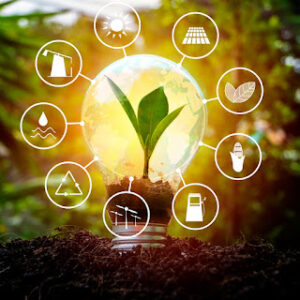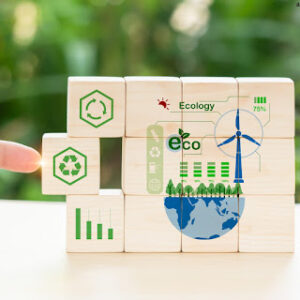
- +254708120315
- vikimsolutions@gmail.com
- Nairobi, Kenya
Circular economy is emerging as an important concept to replace the linear economy model that has developed some issues. Such systems are characterized by a linear economic model which involves taking resources, making products from those resources and then disposing of the products. On the other hand, a regenerative economy is all about trying to utilize resources to their optimum by helping to create a closed work where materials, products and resources which are often referred to as circulations are used again, and re-manufactured or recycled.
The circular economy scenario is an economic concept that focuses on reducing waste and the constant exploitation of resources in an economy or country. It contrasts with the traditional linear economy, which has a straightforward but wasteful model: take resources, create products, use these products, and then finally dispose of the final product, waste. Through encouraging the reuse of material and resources, extending the use of products and substances is made possible hence reducing the impact on the environment as espoused by sustainable economy.
Design Out Waste and Pollution: Consumers exposed to this book will realize that products designed are produced without polluting the environment and causing wastage. This entails utilizing reduced amounts of materials, incorporating renewable resources into existence, and creating products with higher durability and easier recycling.
Keep Products and Materials in Use: This principle lies in the understanding of and the efforts made to enhance the product’s life cycle. This entails methods such as refurbishing, salvaging, renovating, and recovering part or all of an item.
Regenerate Natural Systems: The concept of sustainable economy on the other hand is centered on the given aim of repurposing and reviving ecosystems. This includes recycling some perishable materials to improve soil quality and using natural resources in energy production as a means of reducing limit resource depletion , but more importantly, there are tightly bound economic opportunities among the total set of circular economy ideas.
The transition to a circular economy model can trigger an impressive economic effect. It is inevitable since it opens up new business prospects, cuts down on expenses, and promotes creativity. For instance, it has been observed that through resource recycling instead of reinvestment in virgin resources, companies can lower their costs substantially.
But, if we speak about the environmental advantages of a circular economy, there are numerous. Overall, the deployment of circular economy leads to minimization of natural resource wastage, recycling and reuse of items as well as minimization of pollution and emission of greenhouse gases. They also help to maintain natural resources, thus minimizing distortion of ecosystems and other natural endowments.
However, the circular economy has its own problem and challenges when implemented. Some are technical challenges, financial challenges and the regulatory framework challenges. In the practical sense, the process of designing and sourcing products that are capable of being easily recycled and are of long lasting nature may be challenging. However, the implementation of regenerative economy practices might be expensive in some instances and may involve a significant amount of expenditure at the onset. Challenges related to regulation include the lack of strategic policy or incentives to promote circular economy solutions.
To effectively reduce waste through recycling and reuse, several strategies can be employed:
Product Design: Longevity of products, their ease of repair and recycle is important Longevity, modularity for repair and ease of recycle. This includes adoption of the basic techniques such as the use of modular designs and build material that can be separated for recycling.
Consumer Education: An important due in increasing recycling and reuse is through making the consumers aware of the advantages of practicing the two. For instance, awareness campaigns and educational motivation programs can help support the improvements in consumer responsibility.
Infrastructure Development: Both recycling and waste management have to be efficiently managed and that requires necessary infrastructures. This includes those structures which are used to store collected material, separate the recyclable and non-recyclable materials, and that for converting the collected recyclable material into a usable form.
Policy and Regulation: The policy makers at the government level have a very critical role to play in ensuring the maximum participation of the community in recycling activities through the provision of policies and statutes. This can involve rewards for Circularity where companies engage in more sustainable economy initiatives, sanctions where businesses produce high levels of waste.
Collaboration: The transition towards circular economy is not solely responsibility of businesses or the governments, but rather it is everyone’s duty. Relationships and collaborations can facilitate coordination and enable organizations to leverage their resources.
Today, there is plentiful evidence that the concept of circular economy can work well for a wide range of companies and organizations across the globe. For example, in electronics, from companies such as Fairphone, smartphones have been developed while incorporating modularity of components which are easily detachable and therefore upgradable or replaceable.




Copyright © 2024 Vikim Solutions. All rights reserved.
109 Responses
Your style captivated me from the first sentence, kudos.
The writing skills is amazing, I enjoyed every bit of it.
маркетплейс аккаунтов магазин аккаунтов
аккаунт для рекламы безопасная сделка аккаунтов
купить аккаунт продажа аккаунтов соцсетей
аккаунт для рекламы купить аккаунт
услуги по продаже аккаунтов аккаунты с балансом
площадка для продажи аккаунтов безопасная сделка аккаунтов
маркетплейс аккаунтов https://pokupka-akkauntov-online.ru/
Database of Accounts for Sale Sell Pre-made Account
Profitable Account Sales Buy Account
Online Account Store Account Market
Account Sale Account market
Account Trading Service Purchase Ready-Made Accounts
Accounts market Account Trading
Sell accounts Purchase Ready-Made Accounts
Account Acquisition Account market
Account Trading Account Store
Account Exchange Service https://socialmediaaccountsale.com
account marketplace account trading platform
website for selling accounts accounts market
gaming account marketplace buy accounts
sell accounts account trading
account buying platform account market
sell pre-made account accounts marketplace
secure account sales https://socialaccountsdeal.com
marketplace for ready-made accounts account trading
account trading platform gaming account marketplace
account exchange account catalog
account market account trading service
buy pre-made account account selling platform
accounts market sell pre-made account
secure account sales secure account purchasing platform
ready-made accounts for sale account buying service
buy pre-made account account store
verified accounts for sale website for selling accounts
accounts marketplace gaming account marketplace
database of accounts for sale account buying service
accounts marketplace https://account-buy.org/
accounts market accounts market
secure account purchasing platform accounts marketplace
find accounts for sale social media account marketplace
account selling platform database of accounts for sale
accounts for sale https://accounts-store.org
purchase ready-made accounts accounts marketplace
secure account sales website for selling accounts
account trading platform find accounts for sale
buy account https://accounts-offer.org
social media account marketplace https://accounts-marketplace.xyz/
social media account marketplace https://buy-best-accounts.org
ready-made accounts for sale social-accounts-marketplaces.live
ready-made accounts for sale https://accounts-marketplace.live
account selling service accounts marketplace
secure account purchasing platform accounts marketplace
database of accounts for sale https://buy-accounts-shop.pro
secure account sales https://buy-accounts.live
account sale https://social-accounts-marketplace.live/
account trading platform https://accounts-marketplace.online
account buying service account marketplace
покупка аккаунтов https://akkaunty-na-prodazhu.pro
купить аккаунт https://rynok-akkauntov.top
маркетплейс аккаунтов https://kupit-akkaunt.xyz/
биржа аккаунтов akkaunt-magazin.online
маркетплейс аккаунтов соцсетей купить аккаунт
биржа аккаунтов купить аккаунт
магазин аккаунтов https://akkaunty-optom.live
продажа аккаунтов online-akkaunty-magazin.xyz
магазин аккаунтов https://akkaunty-dlya-prodazhi.pro
маркетплейс аккаунтов https://kupit-akkaunt.online
buy aged fb account facebook ad accounts for sale
facebook ad account buy https://buy-ad-accounts.click
buy facebook accounts buy facebook accounts cheap
buy facebook profile buy aged facebook ads accounts
buy facebook advertising https://ad-account-buy.top
buy facebook ad account https://buy-ads-account.work
facebook ads account for sale buy facebook ad account
buy fb ad account https://buy-ad-account.click
cheap facebook account https://ad-accounts-for-sale.work
buy google ads invoice account https://buy-ads-account.top/
google ads accounts https://buy-ads-accounts.click
facebook accounts for sale facebook ad accounts for sale
google ads accounts https://ads-account-for-sale.top/
google ads accounts for sale https://ads-account-buy.work
buy verified google ads accounts https://buy-ads-invoice-account.top
google ads agency account buy https://buy-account-ads.work
buy google agency account https://buy-ads-agency-account.top
buy google ads invoice account https://sell-ads-account.click/
buy google adwords account https://ads-agency-account-buy.click/
verified bm buy facebook verified business manager
buy google ads verified account https://buy-verified-ads-account.work
buy facebook business manager verified https://buy-bm-account.org
buy business manager facebook buy facebook business manager accounts
buy business manager facebook https://buy-verified-business-manager-account.org
buy facebook business manager account https://buy-verified-business-manager.org
buy facebook business manager accounts https://business-manager-for-sale.org
verified business manager for sale https://buy-business-manager-verified.org
buy verified facebook business manager account buy-bm.org
buy business manager facebook https://verified-business-manager-for-sale.org
buy facebook business managers https://buy-business-manager-accounts.org/
tiktok ads account for sale https://buy-tiktok-ads-account.org
buy tiktok ads https://tiktok-ads-account-buy.org
buy tiktok ads account tiktok ads agency account
buy tiktok ads https://tiktok-agency-account-for-sale.org
tiktok ads agency account https://buy-tiktok-ad-account.org
tiktok ads account buy https://buy-tiktok-ads-accounts.org
tiktok ads agency account https://tiktok-ads-agency-account.org
tiktok ads account buy https://buy-tiktok-business-account.org
tiktok ads account buy https://buy-tiktok-ads.org
Your article helped me a lot, is there any more related content? Thanks!